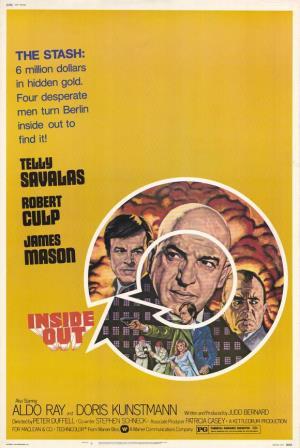THE STASH: 6 Million Dollars in Hidden Gold. Four Desperate Men Turn Berlin Inside Out to Find It!
We’ve all got our favorite actors, and James Mason is one of mine. Though not familiar to most, 1975’s Inside Out, wouldn’t really be classified as a James Mason film as he’s in a partially marginal role as the third lead, after Telly Savalas and Robert Culp.
Mason portrays Ernst Furben, a former concentration camp commandant in 1970s Germany. He reaches out to one of his former prisoners, in the form of down and out (as in about to be evicted) former soldier Harry Morgan (Telly Savalas). His goal is a partnership to reclaim millions of lost Nazi gold. The catch is that there is only one man left alive who knows where it is, and this chap’s the lone inmate in a Berlin prison managed by the four Allied powers in rotating periods. Sound like Spandau and Rudolf Hess, anyone?
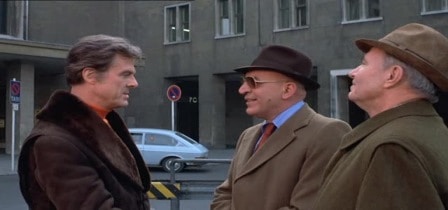 In any case Savalas and Mason partner up with a few other folks, most namely another friend and ex-con in Sly Wells (Robert Culp). Other lesser colleagues include a the American sergeant in charge of the prison (Aldo Ray), and a chronic overeater named, ironically Blimpermann (Peter Schlesinger), who owns a costume shop. There’s also a few other similar folks, all of whom come and go rather quickly after providing their service to the group (with the exception of Culp, who of course plays a major role).
In any case Savalas and Mason partner up with a few other folks, most namely another friend and ex-con in Sly Wells (Robert Culp). Other lesser colleagues include a the American sergeant in charge of the prison (Aldo Ray), and a chronic overeater named, ironically Blimpermann (Peter Schlesinger), who owns a costume shop. There’s also a few other similar folks, all of whom come and go rather quickly after providing their service to the group (with the exception of Culp, who of course plays a major role).
The story itself is rather simple. The crew will secretly swap the prison doctor (Adrian Hoven) with the prisoner for one day, rush the prisoner to a mock Nazi headquarters, and get him to reveal the location of the gold.
Inside Out is decent fun, but at its core it is a rather uninspired execution of a mildly clever plot. Its greatest challenge, however, is that it hasn’t aged well, feeling more like a television movie than a feature film.
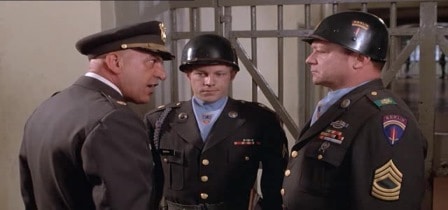 Though Inside Out would have benefited by a standard orchestral score, we are presented by a mix of noise, all of which is punctuated by, of all things, a twangy electric guitar which feels undoubtedly 1970s. Any suspense or drama the film generates is almost instantaneously suspended when you hear what sounds like Charro’s opening number from her latest guest appearance on “The Love Boat.” Culp’s deeply orange-tinted glasses and a few gratuitious “Baby’s” through in throughout the dialogue by Savalas further dampen the realism.
Though Inside Out would have benefited by a standard orchestral score, we are presented by a mix of noise, all of which is punctuated by, of all things, a twangy electric guitar which feels undoubtedly 1970s. Any suspense or drama the film generates is almost instantaneously suspended when you hear what sounds like Charro’s opening number from her latest guest appearance on “The Love Boat.” Culp’s deeply orange-tinted glasses and a few gratuitious “Baby’s” through in throughout the dialogue by Savalas further dampen the realism.
For what it’s worth, both Savalas and Culp are serviceable here, in spite of their faults. Made by a European production company, the casting of Telly Savalas as the lead was surely made to capitalize on his European fame, which was always somewhat greater than that he enjoyed here in the States. He provides about what you’d expect throughout, blustery and forceful dialogues with a few cutesy jokes thrown in- such as buying an entire cake for the feasting Blimpermann, whose already devoured everything on the menu, eventually passing out from overeating for the trouble.
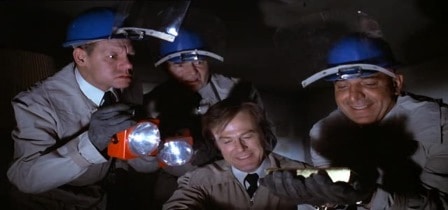 If Savalas as Harry Morgan is the ringmaster of the group, it’s Robert Culp as Sly who does most of the heavy lifting. It’s Sly who photographs the doctor initially with a transsexual to frame him into helping. Sly also gets the decor for the mock headquarters, does all the driving and more. He also has a love interest in nurse Erika (Doris Kunstmann), who helps them drug the prisoner and get him out of the prison. He’s convincing throughout, but one senses too that no great acting was needed (by anyone) here.
If Savalas as Harry Morgan is the ringmaster of the group, it’s Robert Culp as Sly who does most of the heavy lifting. It’s Sly who photographs the doctor initially with a transsexual to frame him into helping. Sly also gets the decor for the mock headquarters, does all the driving and more. He also has a love interest in nurse Erika (Doris Kunstmann), who helps them drug the prisoner and get him out of the prison. He’s convincing throughout, but one senses too that no great acting was needed (by anyone) here.
As for he who brought us here, James Mason fades into almost insignificance as the picture moves on, seemingly appearing only to provide occasional quips in a futile attempt to bring normalcy and reason to the endeavor. Perhaps not getting as down and dirty with Culp and Savalas keeps him above the flippancy, though again by this point Mason was nearing the end of his long career.
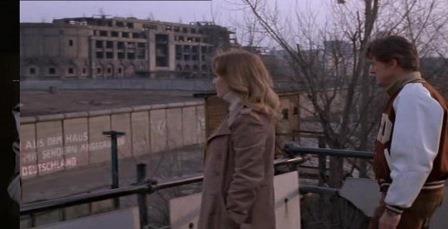 If you look through the credits you’ll find Bond alum Peter Lamont, listed here as art director. The film does provide some great shots of Berlin in the mid-1970s, including the early scene at the carnival and a poignant scene later where Sly and his girlfriend go to an observation tower overlooking the Berlin Wall, reminding us of the dramatic differences between East and West Berlin. The mock-headquarters is also well done.
If you look through the credits you’ll find Bond alum Peter Lamont, listed here as art director. The film does provide some great shots of Berlin in the mid-1970s, including the early scene at the carnival and a poignant scene later where Sly and his girlfriend go to an observation tower overlooking the Berlin Wall, reminding us of the dramatic differences between East and West Berlin. The mock-headquarters is also well done.
For all its inherent faults though, Inside Out is pretty good entertainment. The plot is interesting and though most find the first portion of the film a bit bloated and slow, it’s actually quite effective in showing how the team is assembled (almost similar to The Dirty Dozen. The last forty-five minutes or so are definitely the strong point of the film as that’s when the business starts. Just don’t watch looking for deep thoughts and you’ll be fine.
